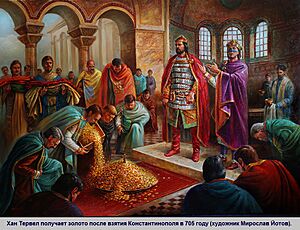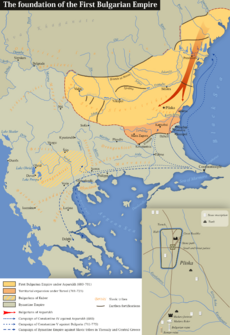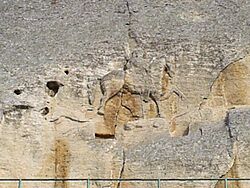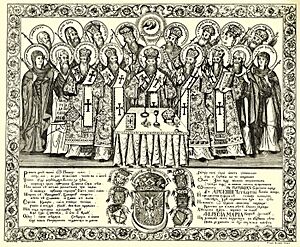Tervel of Bulgaria facts for kids
Quick facts for kids Tervel |
|
|---|---|
| Khan of Bulgaria | |
| Reign | 700–721 |
| Predecessor | Asparukh |
| Successor | Kormesiy |
| Born | 675 Bulgarian Empire |
| Died | 721 Bulgarian Empire |
| Issue | Telerig |
| House | Dulo |
| Father | Asparukh |
Khan Tervel was a powerful ruler of Bulgaria in the early 700s. He was known by different names like Tarvel or Terval. In 705, the Byzantine Emperor Justinian II gave him a special title: Caesar. This was a huge honor, as Tervel was the first non-Byzantine ruler to ever get it!
Tervel was born around 675 in the First Bulgarian Empire. He grew up following the old pagan beliefs, like his grandfather, Khan Kubrat. However, some historians think he might have later become a Christian. Tervel played a super important role in history. He helped defeat a huge Arab army that was trying to conquer the city of Constantinople in 717–718. This battle saved Europe from being taken over by the Arabs. Records show that Tervel was part of the Dulo clan and ruled for 21 years. Many believe he was the son of Asparukh, another famous Bulgarian Khan.
Contents
Tervel's Alliance with Emperor Justinian II
Tervel first appears in history books around 704. At that time, the Byzantine Emperor Justinian II had been kicked out of his throne. Justinian asked Tervel for help to get his empire back. Tervel agreed to help him. In return, Justinian promised friendship, gifts, and even his daughter in marriage.
Tervel gave Justinian an army of 15,000 horsemen. With this help, Justinian marched on Constantinople, the capital city. In 705, they managed to get inside the city. Justinian became emperor again. He punished those who had taken his place. Justinian gave Tervel many gifts. He also gave him the special title of kaisar (Caesar). This meant Tervel was second only to the emperor himself! Tervel also received a piece of land in northeastern Thrace, called Zagora. We don't know if Tervel actually married Justinian's daughter, Anastasia.
Just three years later, Justinian II tried to take back the land he had given to Tervel. But Khan Tervel defeated the Byzantines in a battle near Pomorie in 708. This was called the Battle of Anchialus.
In 711, Justinian II faced another big problem. There was a rebellion in his empire. He asked Tervel for help again. This time, Tervel only sent a small army of 3,000 soldiers. Justinian was captured and killed by the rebels. Tervel's Bulgarian allies were allowed to go home safely. Tervel used this chance to attack Thrace in 712. He took many valuable things and raided areas close to Constantinople.
Historians believe Tervel died around 715. However, some sources suggest he might have been involved in trying to bring back another deposed emperor, Anastasius II, in 718 or 719. If Tervel was still alive then, he would have been the Bulgarian ruler who signed an important new treaty with Emperor Theodosius III in 716. This treaty confirmed that the Byzantines would pay a yearly tribute to Bulgaria. It also set rules for trade and how to handle political refugees.
Many experts agree that the famous Madara Rider rock carving was made during Tervel's time. This amazing monument celebrates his victories over the Byzantines. It also honors his father, Asparukh, and shows the glory of the Bulgarian state.
Defending Europe: The War with the Arabs (717–718)
On May 25, 717, Leo III the Isaurian became the new Emperor of Byzantium. That summer, a huge Arab army and navy, led by Maslama ibn Abd al-Malik, crossed the Dardanelles. They began to surround and attack Constantinople. This was a very serious threat.
Emperor Leo III asked Tervel for help, reminding him of their treaty from 716. Tervel agreed to join the fight. The first battle between the Bulgarians and the Arabs was a big win for the Bulgarians. The Bulgarians attacked the Arab army from behind. A large part of the Arab army was destroyed, and the rest were trapped. The Arabs built two trenches around their camp to protect themselves from the Bulgarian army and the city walls. They kept trying to take the city, even through a very harsh winter with 100 days of snow.
In the spring, the Byzantine navy destroyed Arab ships bringing new supplies. A Byzantine army also defeated Arab reinforcements. Finally, in early summer, the Arabs fought the Bulgarians in a big battle. The Arabs suffered a huge defeat. One historian, Theophanes the Confessor, wrote that the Bulgarians killed about 22,000 Arabs in this battle. Soon after, the Arabs gave up their attack on Constantinople. Tervel's help was crucial in saving the city and stopping the Arab advance into Europe.
In 719, Tervel again got involved in Byzantine politics. The deposed emperor Anastasios II asked Tervel for help to get his throne back. Tervel gave him soldiers and a lot of gold. Anastasios marched to Constantinople, but the people there didn't want to help him. Meanwhile, Leo III sent a letter to Tervel. He asked Tervel to respect their treaty and choose peace over war. Since Anastasios was losing support, Tervel agreed to Leo III's request. He stopped helping Anastasios. Tervel even sent many of the people who had plotted against Leo III back to him.
The Story of Saint Trivelius

In a book called Slav-Bulgarian History from 1762, a monk named Paisius of Hilendar wrote about Tervel. He looked at an old picture that showed Saint David and Saint Theoctistus. Paisius thought that Saint Theoctistus in the picture was actually King Trivelius, or Tervel.
Paisius wrote that King Trivelius was the first Bulgarian ruler to become a Christian around 703 AD. He said that Tervel was very religious after becoming Christian. Because of this, he built a monastery for himself. He then chose to leave his kingdom and become a monk. Paisius claimed Tervel's monk name was Theoctist.
Other old books from that time also tried to find Tervel's monastery. Some even said his relics (remains) were still in Ohrid. It's interesting that these stories about King Trivelius as a saint first appeared in Balkan books in the 1700s. Before that, Western books had mentioned him, but not as a monk or saint. Paisius might have been the first to connect Tervel with the name Theoctist. He knew that a Serbian king named Dragutin had also become a monk with the name Theoctist.
Another picture from 1741, made by the same artist, Hristofor Žefarović, helps us understand the image of Saint Theoctistus. This picture shows Saint Sava with Serbian saints. It was made to celebrate Empress Maria Theresa becoming queen. All the saints in this picture are from the Serbian royal family. This suggests that the Saint Theoctistus in these pictures is likely connected to the Serbian royal family, not Tervel.
Later Bulgarian writers used Paisius's ideas without checking them carefully. This led to a made-up saint cult for Tervel. This idea was then shown in paintings from the 1700s and 1800s.
Legacy
Tervel Peak, a mountain on Livingston Island in Antarctica, is named after Tervel of Bulgaria.
See also





